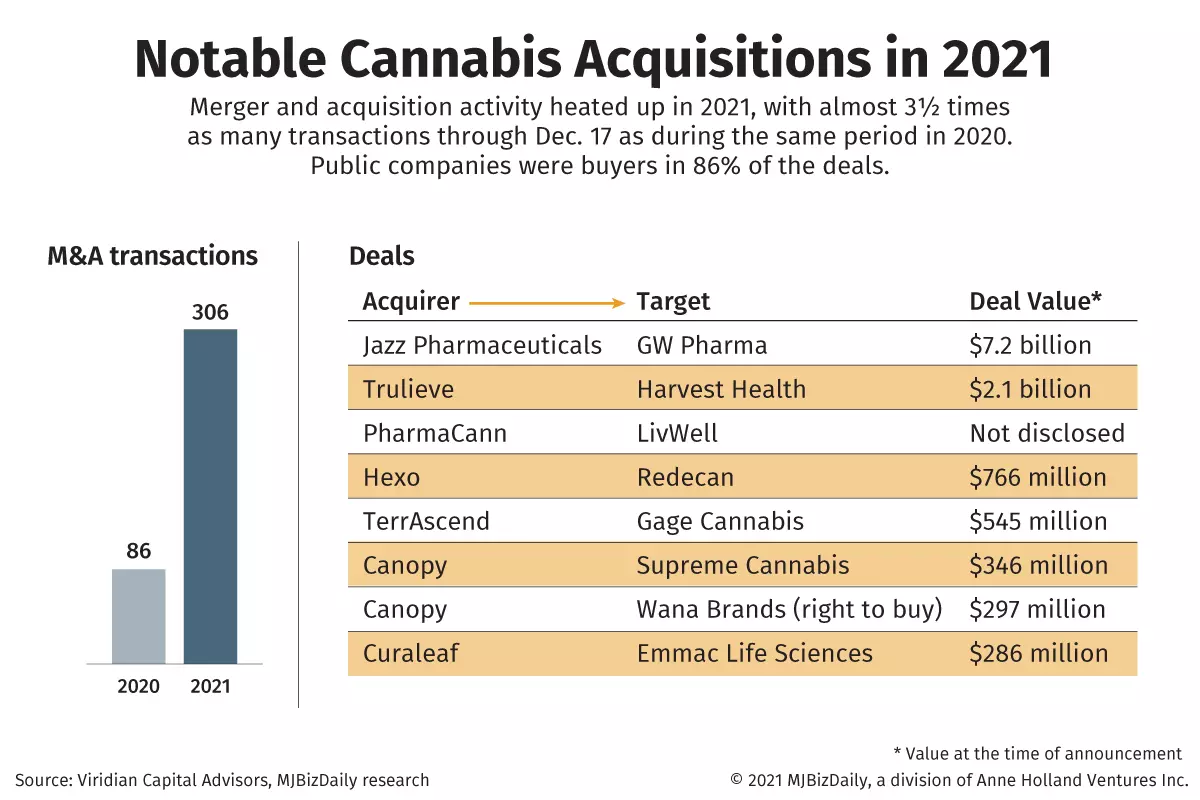Political and pandemic upheavals made 2020 an exceptional year.
And the roller-coast ride failed to slow in 2021, marking a second straight year of extreme unpredictability for the cannabis industry.
- Would marijuana retail sales continue to skyrocket, with more and more pandemic-weary consumers seeking out cannabis for stress relief?
- Would the new Democratic president and Congress be able to push through landmark cannabis reform legislation?
- Would investors resume writing big checks for cannabis companies?
As 2021 comes lurching to an end, it’s worth considering how these and other questions actually unfolded over the past year.
Below are five charts to help explain the state of the cannabis industry in 2021:

After sales soared to record highs in 2020 amid the pandemic, analysts wondered if the trend would continue in 2021. It did not.
Marijuana retail sales, while continuing to show growth in some areas, decelerated from the torrid pace set in 2020.
The pace of sales began to slow after the unofficial 4/20 holiday and have yet to recover their earlier momentum. It could be a harbinger heading into 2022.

Lawmakers and governors stepped up in 2021 by producing a record number of legislative-driven marijuana markets.
Connecticut, New Mexico, New York and Virginia approved adult-use markets in 2021, while Alabama’s lawmakers and governor signed off on a new medical program
The MJBizFactbook projects those five markets together will generate more than $5.1 billion in annual sales by their fourth year of operation.
The trend reflects how marijuana legalization is increasingly being driven by lawmakers and governors rather than citizen-led initiatives.

Total debt and capital raises in 2021 as of Dec. 15 topped $12 billion, according to New York-based Viridian Capital Advisors.
That was enough to top 2020 raises, but this year’s total was $2 billion shy of the peak in 2018.
Debt raises were the story in 2021.
Low stock prices and hopes of banking reform saw more companies tilting toward debt financing.
Stay informed with MJBiz Newsletters
MJBiz’s family of newsletters gives cannabis professionals an edge in this rapidly changing industry.
Featured newsletters:
- MJBizDaily: Business news for cannabis leaders in your inbox each morning
- MJBiz Cultivator: Insights for wholesale cannabis growers & vertically integrated businesses
- MJBizCon Buzz: Behind-the-scenes buzz on everything MJBizCon
- MJBiz Retail + Brand: New products, trends and news for cannabis retailers, distributors and marketers
- Hemp Industry Week: Roundup of news from hemp farming to CBD product manufacturing
- And more!
U.S debt raises were up $2.7 billion, or 673%, in 2021 versus 2018, with the average debt raise of $48.1 million more than double that in 2020.
Equity raises in the U.S. also were up, climbing 62% versus 2018.
Look for this trend to continue.
Viridian predicts that debt will become cheaper even for smaller operators. The improved funding climate is expected to accelerate mergers and acquisitions, among other things.

Congress continued to introduce and push cannabis legislation in 2021, a trend that began in the 70s. But it has since gained momentum.
And while many lawmakers are enthusiastic, that enthusiasm has so far failed to translate into major cannabis reform.
Only one bill containing the words “cannabis,” “marijuana” or “hemp” in the headline or text was signed into law this year: the Infrastructure Investment and Jobs Act.
As 2021 began, glimmers of hope emerged in Congress with the introduction of 69 bills or resolutions between both chambers. That included the SAFE Banking Act, which the House again passed in 2021.
Some lawmakers, including Rep. Ed Perlmutter of Colorado, remain optimistic that President Joe Biden will sign that bill into law in 2022.

Cannabinoids – other than CBD – made a big splash in 2021.
Cannabis companies used new, faster production methods to make CBN products more available to consumers.
The CBN products, often combined with THC, leveraged the compound’s reputation as a sleep aid.
As a result, CBN experienced growing success in 2021, claiming more than 14% of retail sales of edibles in the California recreational market.
CBN saw similar gains in other Western states. The trend might show a path to retail for other cannabinoids.
Andrew Long can be reached at andrew.long@mjbizdaily.com.





